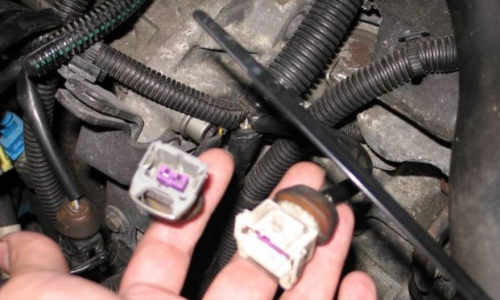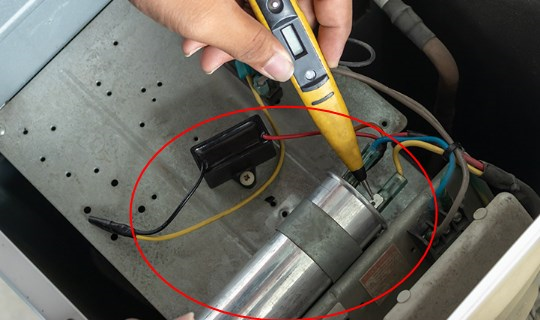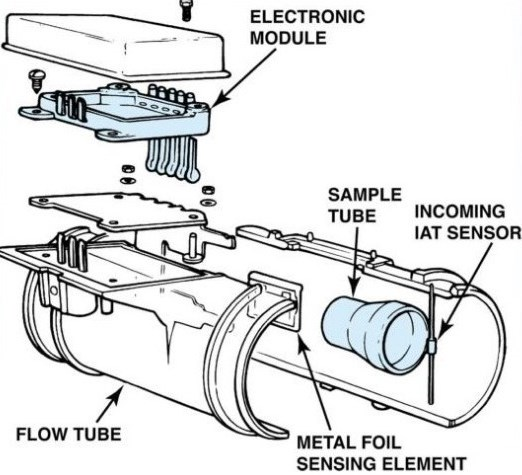Have you ever been in a situation where the accelerator failed while you were driving?
It's an annoying thing to have a car malfunction like this, especially on the highway. So what's causing the throttle to fail? It could be related to a widget of automotive electronic control system - the throttle position sensor.
Here, we’ll go through what a TPS is and what is its function. Then this article will offer you two methods of checking TPS.
Hopefully, you will know exactly how to check if throttle position sensor is bad after reading.

What Is A Throttle Position Sensor
A throttle position sensor (TPS) is a device that monitors the position of the throttle valve in an internal combustion engine. The throttle position sensor is usually located on the butterfly spindle so that it can directly monitor the position of the throttle valve.
The TPS sends the position of the throttle valve to the engine control unit (ECU) or powertrain control module (PCM). This information is crucial for the engine management system to determine how much air is entering the engine. Based on the throttle position sensor's data, the ECU can adjust the air-fuel mixture and control other aspects of the engine operation to ensure smooth performance, fuel efficiency, and emissions control.
A faulty throttle position sensor can cause various issues such as poor acceleration, rough idling, stalling, or incorrect transmission shifting. It is essential to ensure that the throttle position sensor is functioning correctly to maintain optimal engine performance. If you suspect an issue with the TPS, it is recommended to have it inspected and replaced if necessary by a qualified mechanic.

Types of Throttle Position Sensor
Throttle position sensors (TPS) come in different types based on their design and technology used to measure throttle position. Here are two common types of throttle position sensors:
-
Potentiometer-based TPS (Analog TPS):
- Potentiometer: This type of TPS uses a potentiometer (variable resistor) to measure the position of the throttle valve. As the throttle valve opens or closes, the resistance in the potentiometer changes, providing a variable voltage signal to the engine control unit (ECU).
- Analog Output: Analog TPS sensors generate a variable analog voltage signal that corresponds to the throttle position. The ECU interprets this voltage signal to determine the throttle angle and adjust engine fuel delivery and ignition timing accordingly.
-
Hall Effect TPS (Digital TPS):
- Hall Effect Sensor: Digital TPS sensors use a Hall effect sensor to measure the position of the throttle valve. The Hall effect sensor generates a digital signal that is sent to the ECU to indicate the throttle position.
- Digital Output: Hall Effect TPS sensors provide a digital (on/off) signal to the ECU, which simplifies signal processing and can improve accuracy and reliability compared to analog TPS sensors.
Both types of throttle position sensors serve the same basic function of monitoring the position of the throttle valve and providing feedback to the engine control unit to optimize engine performance. The choice between analog and digital TPS sensors may depend on factors such as system requirements, cost considerations, and compatibility with the vehicle's engine control system. Digital TPS sensors are generally more common in modern vehicles due to their accuracy and reliability.
It's essential to choose the right type of throttle position sensor for your vehicle and ensure that it is properly calibrated and functioning correctly to maintain optimal engine performance and drivability. If you suspect any issues with the throttle position sensor, it is recommended to have it inspected by a qualified mechanic to diagnose and address the problem effectively.

What Is the Function of A Throttle Position Sensor
The throttle position sensor (TPS) plays a crucial role in the operation of an internal combustion engine by monitoring the position of the throttle valve and providing this information to the engine control unit (ECU) or powertrain control module (PCM). The main functions of a throttle position sensor include:
-
Throttle Position Monitoring: The primary function of the TPS is to monitor the position of the throttle valve in the intake manifold. It detects how much the throttle valve is open or closed, indicating the driver's input regarding acceleration or deceleration.
-
Fuel Delivery Adjustment: By continuously monitoring the throttle position, the TPS helps the ECU determine the appropriate air-fuel mixture ratio required for optimal engine performance. Based on the throttle position data, the ECU adjusts the fuel delivery to ensure efficient combustion and power output.
-
Ignition Timing Control: The signal from the TPS is also used by the ECU to adjust the ignition timing according to the engine load and throttle position. This helps optimize engine performance, fuel efficiency, and emissions control.
-
Transmission Shift Control: In vehicles with automatic transmissions, the TPS signal is used to assist in transmission shift points. The ECU can adjust the transmission shifting based on throttle position data to provide smooth acceleration and optimal performance.
-
Idle Control: The TPS signal is essential for maintaining smooth idling of the engine. The ECU uses the throttle position information to adjust the idle speed and prevent stalling when the vehicle is stationary.
-
Diagnosis of Malfunctions: The TPS also aids in diagnosing engine-related issues. If the TPS malfunctions or provides erratic signals, the ECU can trigger a diagnostic trouble code (DTC) and illuminate the check engine light to alert the driver of a potential problem.
Overall, the throttle position sensor is a critical component that helps in regulating engine performance, fuel efficiency, emissions control, and overall drivability. Ensuring that the TPS is working correctly and providing accurate data to the ECU is essential for the proper functioning of the engine and related systems in a vehicle.

How to Check Throttle Position Sensor(2 Methods For You)
Certainly! Here are two methods to check the throttle position sensor (TPS) on a vehicle:
Method 1: Using a Multimeter
Tools Required:
- Multimeter
- Safety goggles (for eye protection)
Steps:
-
Locate the TPS: Find the throttle position sensor on your vehicle. It is usually located on the throttle body or near the throttle plate.
-
Disconnect the TPS: Disconnect the electrical connector from the TPS.
-
Set the Multimeter: Set the multimeter to measure resistance (ohms) or voltage based on the type of TPS in your vehicle (analog or digital).
-
Probe Connections: Connect the positive lead of the multimeter to the signal wire terminal on the TPS and the negative lead to the ground wire terminal.
-
Read the Readings: With the ignition in the ON position (engine off), move the throttle from closed to fully open position slowly. The resistance or voltage should change smoothly with throttle movement. If the change is erratic or if there are dead spots, the TPS may be faulty.
-
Compare Readings: Refer to the vehicle's service manual for specific resistance or voltage values corresponding to different throttle positions. Compare your readings to the specified values to determine if the TPS is functioning correctly.
Method 2: Using a Scan Tool
Tools Required:
- OBD-II scan tool
Steps:
-
Connect the Scan Tool: Plug the OBD-II scan tool into the diagnostic port of your vehicle, usually located under the dashboard.
-
Read TPS Data: Access the live data or sensor data menu on the scan tool and locate the throttle position sensor parameter.
-
Throttle Position Readings: With the ignition on (engine off), observe the throttle position sensor readings as you slowly open and close the throttle. The readings should change smoothly and consistently with throttle movement.
-
Analyze the Data: Compare the TPS readings on the scan tool to the specified values for different throttle positions. Any inconsistencies or erratic behavior in the readings may indicate a faulty TPS that requires replacement.
By following these methods, you can effectively check the throttle position sensor on your vehicle to ensure that it is functioning correctly and providing accurate data to the engine control unit for optimal engine performance and drivability.
The Signs that the Throttle Position Sensor Is Bad
A faulty or failing throttle position sensor (TPS) can cause a variety of issues in a vehicle. Here are some common signs that indicate a potential problem with the throttle position sensor:
-
Poor Engine Performance:
- Hesitation or Stumbling: The engine may hesitate or stumble during acceleration, especially at low speeds.
- Lack of Power: The vehicle may lack power or struggle to accelerate smoothly.
- Surging: The engine may surge or fluctuate in RPM without driver input.
-
Rough Idle:
- Fluctuating Idle Speed: The engine may experience fluctuating idle speed or struggle to maintain a consistent idle.
- Stalling: The engine may stall frequently, especially when idling or coming to a stop.
-
Unpredictable Throttle Response:
- Delayed Throttle Response: The vehicle may have a delay in throttle response when accelerating.
- Inconsistent Acceleration: Acceleration may feel inconsistent or jerky.
-
Transmission Shifting Issues:
- Harsh Shifting: The transmission may shift abruptly or more forcefully than usual.
- Incorrect Shift Points: The transmission may not shift at the appropriate points based on throttle input.
-
High Fuel Consumption:
- Decreased Fuel Efficiency: A faulty TPS can disrupt the engine's fuel management system, leading to decreased fuel efficiency and increased fuel consumption.
-
Check Engine Light:
- Illuminated Check Engine Light: A malfunctioning TPS can trigger the Check Engine Light (CEL) on the dashboard. Retrieving the diagnostic trouble codes (DTCs) using an OBD-II scanner can help identify TPS-related issues.
-
Engine Misfires:
- Misfiring Engine: A failing TPS can contribute to engine misfires, leading to rough running or a noticeable lack of power.
-
Poor Emissions:
- Increased Emissions: A malfunctioning TPS may lead to increased emissions due to improper air-fuel ratio control and combustion inefficiencies.
If you notice any of these signs or symptoms in your vehicle, it is advisable to have the throttle position sensor inspected and tested by a qualified mechanic. Prompt diagnosis and replacement of a faulty TPS can help restore optimal engine performance, fuel efficiency, and drivability.
Conclusion
In conclusion, identifying signs of a failing throttle position sensor (TPS) is crucial for maintaining the performance and efficiency of a vehicle. Symptoms such as poor engine performance, rough idle, unpredictable throttle response, transmission shifting issues, high fuel consumption, the illumination of the Check Engine Light, engine misfires, and poor emissions can indicate potential TPS problems.
Promptly addressing TPS issues by having the sensor inspected and replaced by a qualified mechanic can help prevent further damage to the vehicle and restore optimal engine function. Regular maintenance and timely repairs play a significant role in ensuring the smooth operation and longevity of the vehicle. If you suspect TPS-related issues based on the observed symptoms, seeking professional assistance and diagnostic testing is recommended to address the problem effectively.


